Since our founding over a century ago, the Brady Urological Institute has been the epicenter for urologic care, research and education. We’ve led some of the most impactful advances in the field, including developing the nerve-sparing prostatectomy and identifying the first human gene mutation in prostate cancer. Revisit the people and discoveries that have helped shape our course.
-
Past Leadership
Meet previous department and research directors — titans in the field of urology.
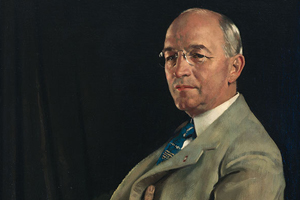
-
Timeline of Achievements
Track the evolution of urology at Johns Hopkins, from the early 1900s to today.
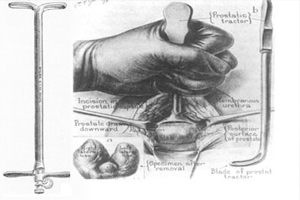
-
Books
Past and present leaders chronicle the history of urology at Johns Hopkins.
-
Videos
Archival footage of surgical procedures and interviews with Brady legends.
-
Articles
Journal articles documenting more than 100 years of discovery and progress.
-
Photos
A look back at the founding of the Brady Institute and the experts who shaped it.
-
Presentations
Brady leaders detail the past, present and future of urologic discovery.
Books
The Brady 100 Years

Urology at Hopkins: A Chronicle

Hugh Young: A Surgeon's Autobiography

Videos
Simple Perineal Prostatectomy performed by Hugh H. Young (circa 1933)
Urology at Johns Hopkins (1979)
The Walsh Nerve-sparing Technique for Radical Retropubic Prostatectomy and Cystoprostatetctomy (1985)
Radical Retropubic Prostatectomy: A Detailed Description of the Surgical Technique (2004)
Celebration of Patrick and Margaret Walsh: 30 Years of Contributions to Brady (2004)
Alpha Omega Alpha Leaders in American Medicine: Dr. Patrick C. Walsh Interview (1999)
The Donald Coffey Story
A Tribute to Dr. Patrick C. Walsh
If You Don't Know Where You Are Going, How Will You Ever Get There? | Patrick C. Walsh, M.D.
Articles
-
-
-
1920
Observations on gun-shot wounds of the urethra
1921
Physiological and pharmacological studies of the prostate gland
1922
An operation for the cure of incontinence associated with espispadias
1923
The treatment of septicemia and local infections
1924
Secondary closure of tuberculous nephrectomy wounds
1925
Presentation of preoperative skin disinfectant—an alcohol- acetone-aqueous solution of mercurochrome
1926
Deep roentgen-ray therapy in the treatment of carcinoma of the bladder
1928
Vas ligation for the prevention of preoperative and post-operative epididymitis
-
1930
Medical Aspects of the treatment of benign prostatic hypertrophy
1931
A radical operation for the cure of cancer of the penis
1932
Carcinoma of the prostate, a clinical and pathological study
1934
Radiation Therapy of renal cortical neoplasms
1935
Bladder abnormalities due to injury of motor pathways in the nervous system
1937
The use of sulfanilamide in gonococcic infections
1939
-
1940
Stenosis of the ureteropelvic juncture: congenital and acquired
1941
Postoperative venous thrombosis and pulmonary embolism
1943
1944
The excretion of 07- ketosteroids in carcinoma of the prostate
1945
Treatment of bladder dysfunction after neurologic trauma
1946
1947
Endocrine therapy in carcinoma of the prostate
1948
A new concept in the treatment of Peyronie's disease
1949
-
1950
1951
Renal trauma: a study of 71 cases
1952
Infiltrating carcinoma of the bladder
1953
1954
1955
Operation for tumor of a solitary kidney
1956
Significance of the palpable prostatic nodule
1957
Steroid response to therapy in prostatic cancer
1958
The surgical treatment of carcinoma of the bladder
1959
-
1960
Carcinoma of the bladder: characteristic modes of local invasion
1961
Functional characteristics of renovascular hypertension
1962
Hypophysectomy for disseminated prostatic cancer
1963
Radiographic evaluation of the bladder neck in childhood
1964
The effect of hypothermia upon respiration and anaerobic glycolysis of dog kidney
1965
Androgenic Control of Nucleic Acid and Protein Synthesis in Male Accessory Genital Organs
-
1971
Androgenic Control of Nucleic Acid and Protein Synthesis in Male Accessory Genital Organs
1972
1973
Bladder exstrophy: Vesicoplasty or urinary diversion?
1974
Permanent urinary diversion in childhood
1975
Nuclear Protein Matrix: Association with Newly Synthesized DNA
1976
The Induction of Prostatic Hypertrophy in the Dog with Androstanediol
1978
Characterization of the Binding of a Potent Synthetic Androgen, Methyltrienolone, to Human Tissues
1979
Comparison of spontaneous and experimentally induced canine prostatic hyperplasia
-
1980
Supercoiled loops and eucaryotic DNA replication
1980
A fixed site of DNA replication in eucaryotic cells
1981
- Pathological factors that influence prognosis in stage A prostatic cancer: the influence of extent versus grade
- Genetic Instability Coupled to Clonal Selection as a Mechanism for Tumor Progression in the Dunning R-3327 Rat Prostatic Adenocarcinoma System
1982
Impotence following radical prostatectomy: insight into etiology and prevention
1983
1986
1986
1988
Activation of programmed cell death in the rat ventral prostate after castration
1989
Etiology and disease process of benign prostatic hyperplasia
-
1990
- Allelic loss of chromosomes 16q and 10q in human prostate cancer
- Programmed Cell Death during Regression of PC-82 Human Prostate Cancer following Androgen Ablation
1992
- Longitudinal Evaluation of Prostate-Specific Antigen Levels in Men With and Without Prostate Disease
- Nitric oxide: a physiologic mediator of penile erection.
- Mendelian inheritance of familial prostate cancer
- The Effect of Finasteride in Men with Benign Prostatic Hyperplasia
1994
- Pathologic and Clinical Findings to Predict Tumor Extent of Nonpalpable(Stage T1 c) Prostate Cancer
- The Role of Calcium, pH, and Cell Proliferation in the Programmed (Apoptotic) Death of Androgen-independent Prostatic Cancer Cells Induced by Thapsigargin
- Cytidine methylation of regulatory sequences near the a-class glutathione S-transferase gene accompanies human prostatic carcinogenesis
1995
- KAI1, a metastasis suppressor gene for prostate cancer on human chromosome
- Laparoscopic Live Donor Nephrectomy
1996
- Major Susceptibility Locus for Prostate Cancer on Chromosome 1 Suggested by a Genome-Wide Search
- Telomerase Activity: A Prevalent Marker of Malignant Human Prostate Tissue
1997
- Prostate Attenuated Replication Competent Adenovirus (ARCA) CN706: A Selective Cytotoxic for Prostate-specific Antigen-positive Prostate Cancer Cells
- Specific and Efficient Peptide Substrates for Assaying the Proteolytic Activity of Prostate-specific Antigen
- Prostate Attenuated Replication Competent Adenovirus (ARCA) CN706: A Selective Cytotoxic for Prostate-specific Antigen-positive Prostate Cancer Cells
1998
- Use of the Percentage of Free Prostate-Specific Antigen to Enhance Differentiation of Prostate Cancer From Benign Prostatic Disease
- Analysis of Percent Free Prostate-Specific Antigen (PSA) for Prostate Cancer Detection: Influence of Total PSA, Prostate Volume, and Age
1999
- Natural History of Progression After PSA Elevation Following Radical Prostatectomy
- Proliferative Inflammatory Atrophy of the Prostate Implications for Prostatic Carcinogenesis
- Induction of Immunity to Prostate Cancer Antigens: Results of a Clinical Trial of Vaccination with Irradiated Autologous Prostate Tumor Cells Engineered to Secrete Granulocyte-Macrophage Colony-stimulating Factor Using ex Vivo Gene Transfer
- Overexpression of Hypoxia-inducible Factor 1α in Common Human Cancers and Their Metastases
-
2000
2001
- Human Prostate Cancer and Benign Prostatic Hyperplasia: Molecular Dissection by Gene Expression Profiling
- A Phase I Trial of CV706, a Replication-competent, PSA Selective Oncolytic Adenovirus, for the Treatment of Locally Recurrent Prostate Cancer following Radiation Therapy
2002
- α-Methylacyl-CoA Racemase: A New Molecular Marker for Prostate Cancer
- Identification and Characterization of Nuclease-stabilized RNA Molecules That Bind Human Prostate Cancer Cells via the Prostate-specific Membrane Antigen
- Telomere Shortening Is an Early Somatic DNA Alteration in Human Prostate Tumorigenesis
2003
Prostate-Specific Antigen-Activated Thapsigargin Prodrug as Targeted Therapy for Prostate Cancer
2004
Docetaxel plus Prednisone or Mitoxantrone plus Prednisone for Advanced Prostate Cancer
2005
- Phosphodiesterase-5A dysregulation in penile erectile tissue is a mechanism of priapism
- Androgen ablation mitigates tolerance to a prostate/prostate cancer-restricted antigen
- The 2005 International Society of Urological Pathology(ISUP) Consensus Conference on Gleason Grading of Prostatic Carcinoma
- Risk of Prostate Cancer-Specific Mortality Following Biochemical Recurrence After Radical Prostatectomy
2006
2007
A New Type of Motor: Pneumatic Step Motor
2008
- Nuclear MYC protein overexpression is an early alteration in human prostate carcinogenesis
- A Molecular Analysis of Prokaryotic and Viral DNA Sequences in Prostate Tissue From Patients With Prostate Cancer Indicates the Presence of Multiple and Diverse Microorganisms
- Prostate Cancer-Specific Survival Following Salvage Radiotherapy vs Observation in Men With Biochemical Recurrence After Radical Prostatectomy
- Cumulative Association of Five Genetic Variants with Prostate Cancer
2009
- Ligand-independent Androgen Receptor Variants Derived from Splicing of Cryptic Exons Signify Hormone Refractory Prostate Cancer
- Copy Number Analysis Indicates Monoclonal Origin of Lethal Metastatic Prostate Cancer
- miR-21: An androgen receptor regulated microRNA which promotes hormone dependent and independent prostate cancer growth
- Acute inflammatory proteins constitute the organic matrix of prostatic corpora amylacea and calculi in men with prostate cancer
-
2010
Androgen-induced TOP2B mediated double strand breaks and prostate cancer gene rearrangements
2011
2012
- Germline Mutations in HOXB13 and Prostate Cancer Risk
- African American Men With Very Low–Risk Prostate Cancer Exhibit Adverse Oncologic Outcomes After Radical Prostatectomy: Should Active Surveillance Still Be an Option for Them?
2013
Opening of the Brady Urological Institute
-
James Buchanan Brady (Milestone)
James Buchanan Brady (1856–1917)
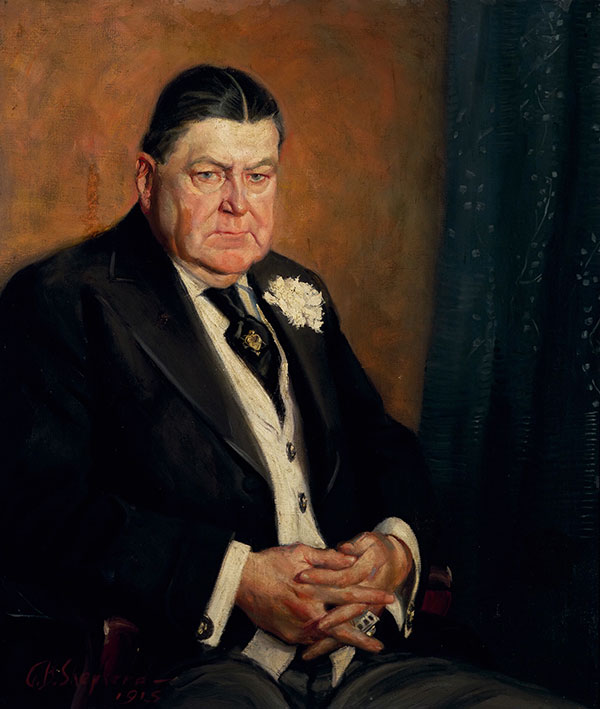
The Brady Urological Institute, given through the generosity of James Buchanan Brady, opened January 21, 1915.
About the Benefactor
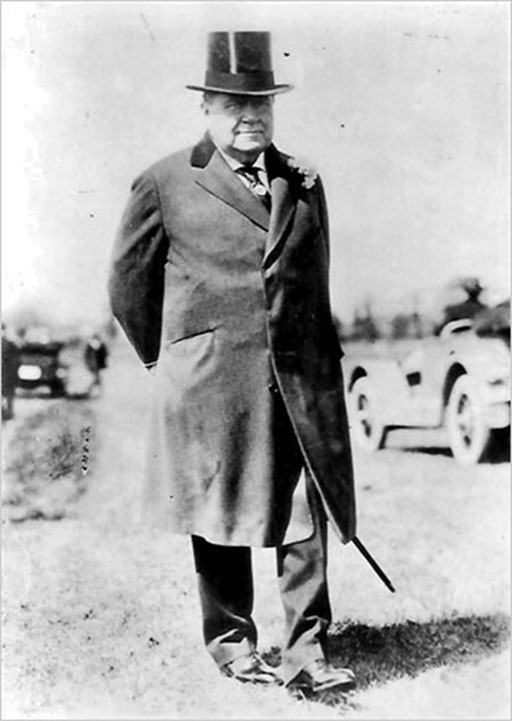
James Buchanan Brady, who made his fortune ($12 million) in the railroad supply industry, had a passion for fine clothes, expensive jewelry and food, and was the first person in New York City to own an automobile.
James Buchanan Brady (Milestone) :
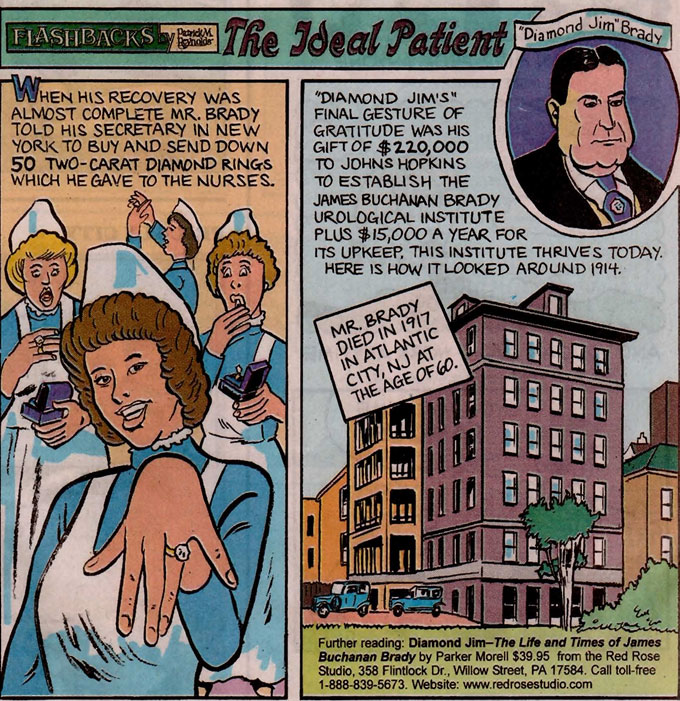
“Diamond Jim” Brady Shares His wealth with Johns Hopkins
-
Construction on the Brady Urological Institute - 1914 (Location) :
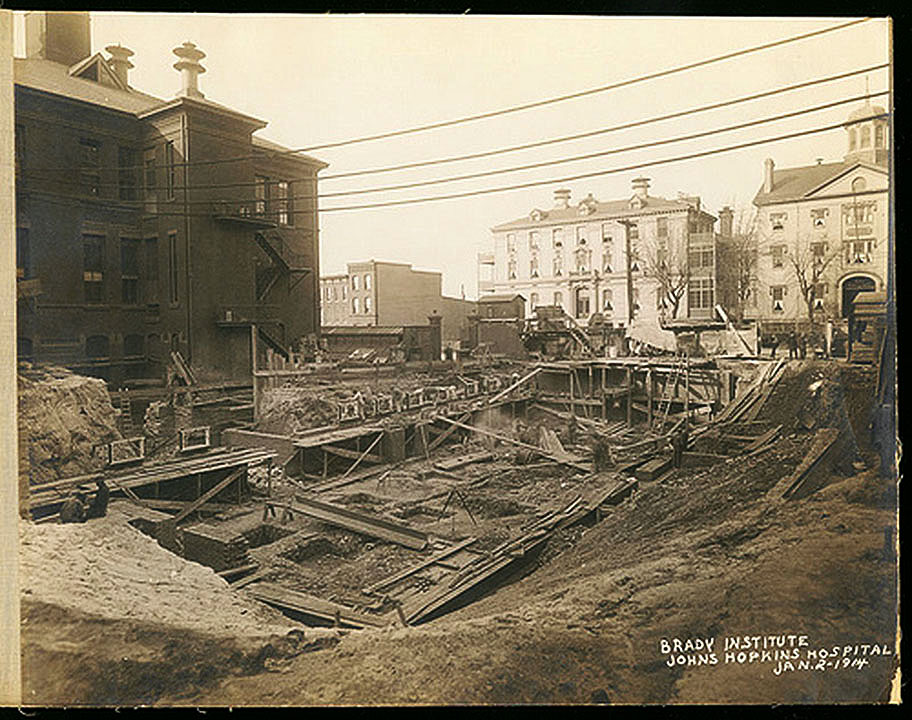
Construction on the Brady Urological Institute - 1914 (Document) :
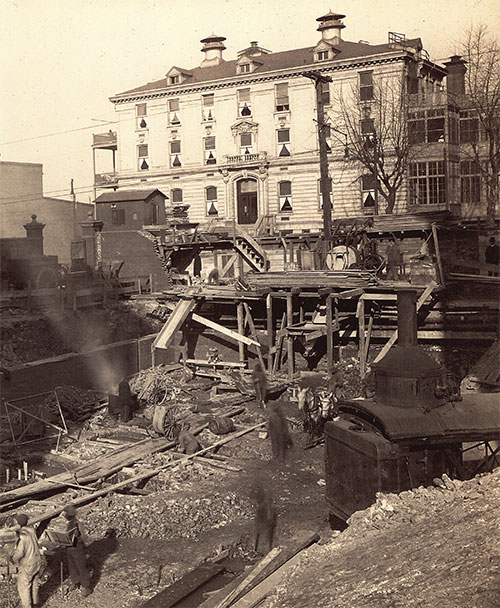
Construction on the Brady Urological Institute - 1914 (Document) :
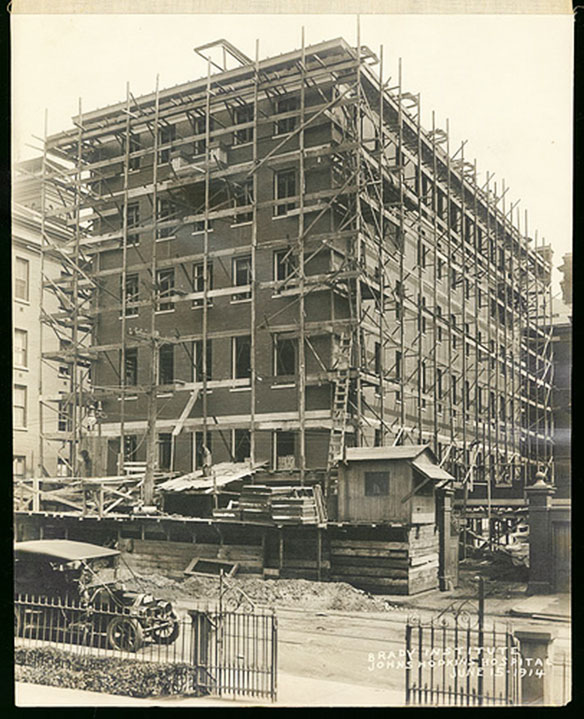
-
The Brady Urological Institute Building Opened - 1915 (Location) :
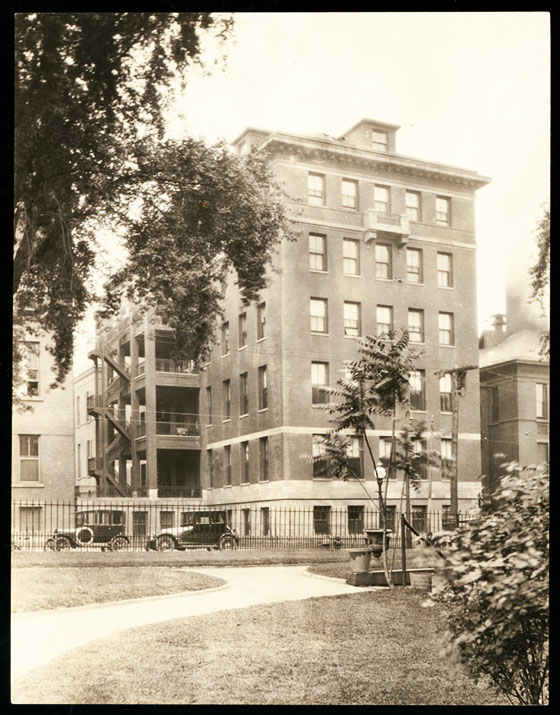
-
Johns Hopkins Hospital Campus (Image) :
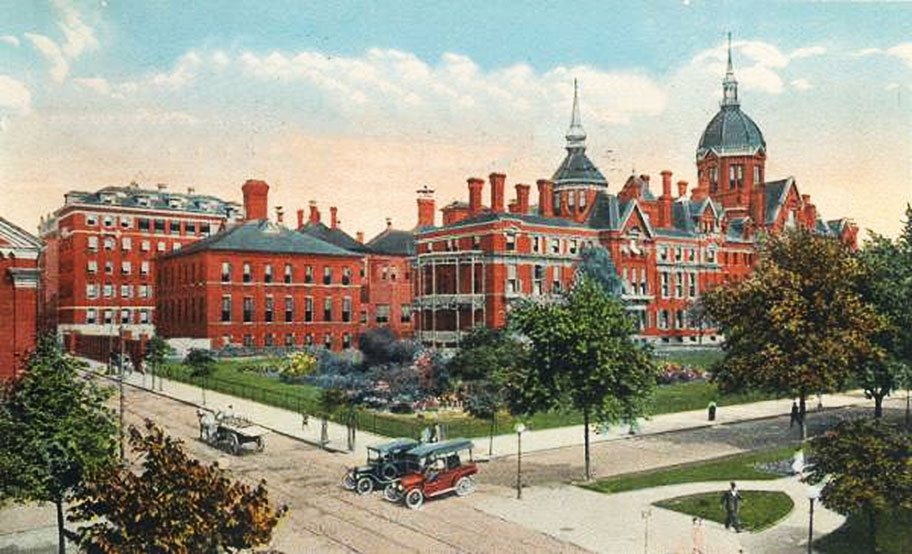
Illustration of the Johns Hopkins Hospital campus
Brady Urological Institute 1946–1974
-
1973-1974 (Milestone) :
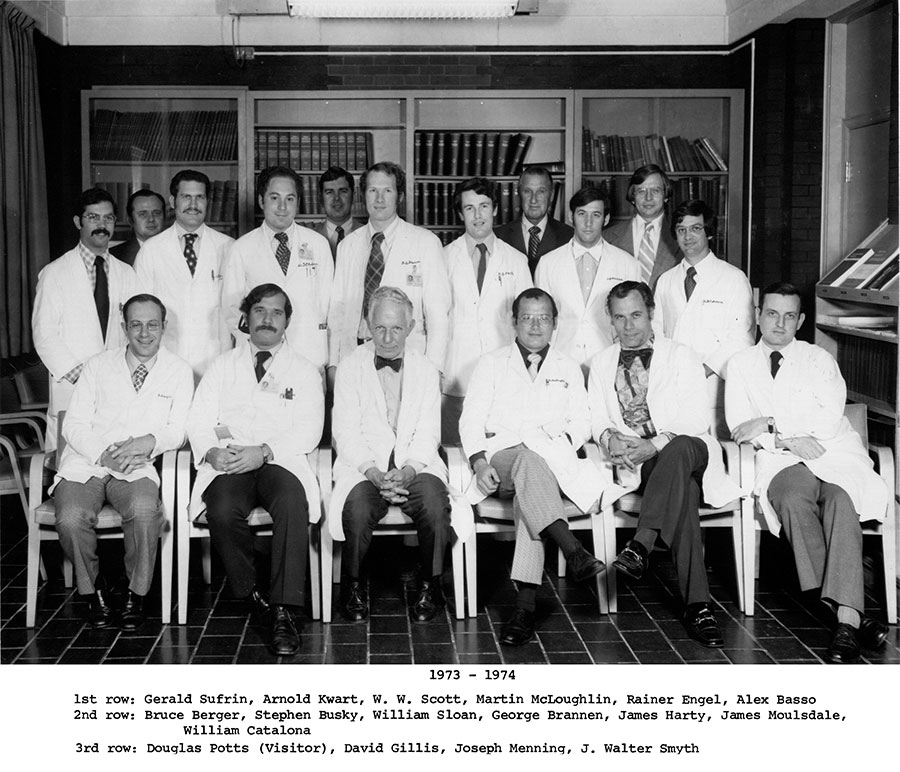
-
William W. Scott (Image) :
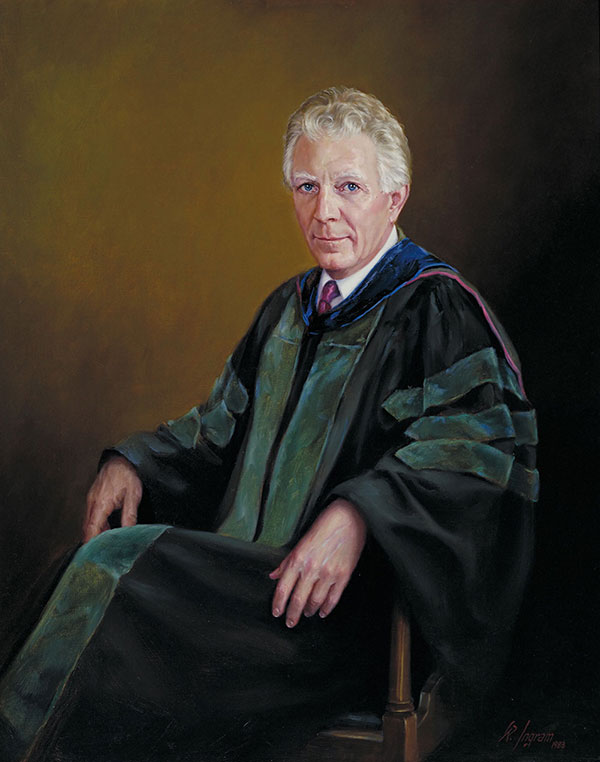
-
Brady Urological Institute (Image) :
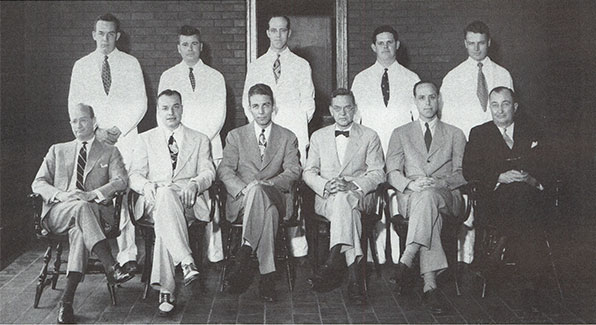
Brady Urological Institute (Document) :
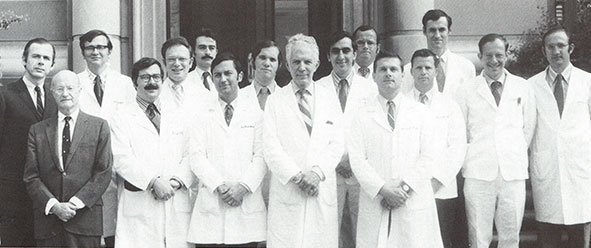
Brady Urological Institute 1974–2004
-
1986–1987 (Image):
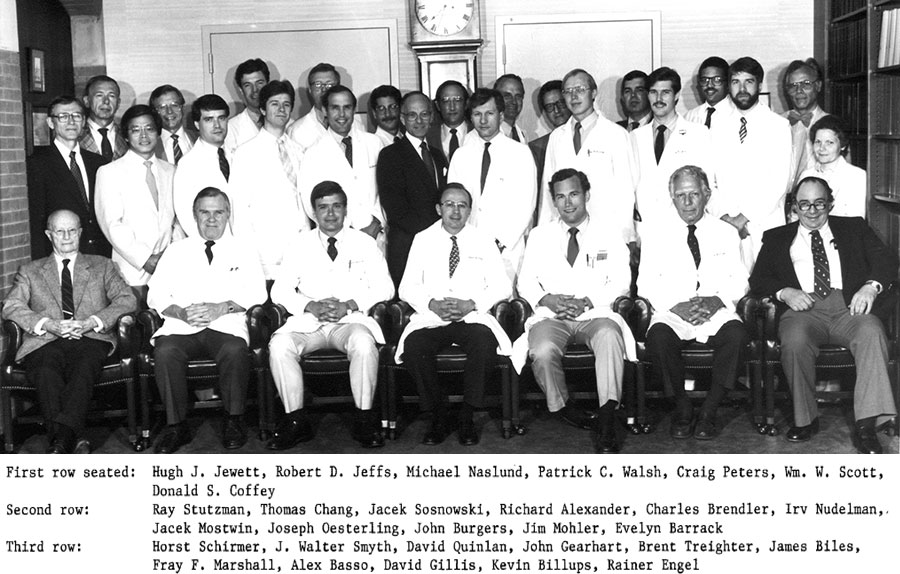
-
1987–1988 (Image):
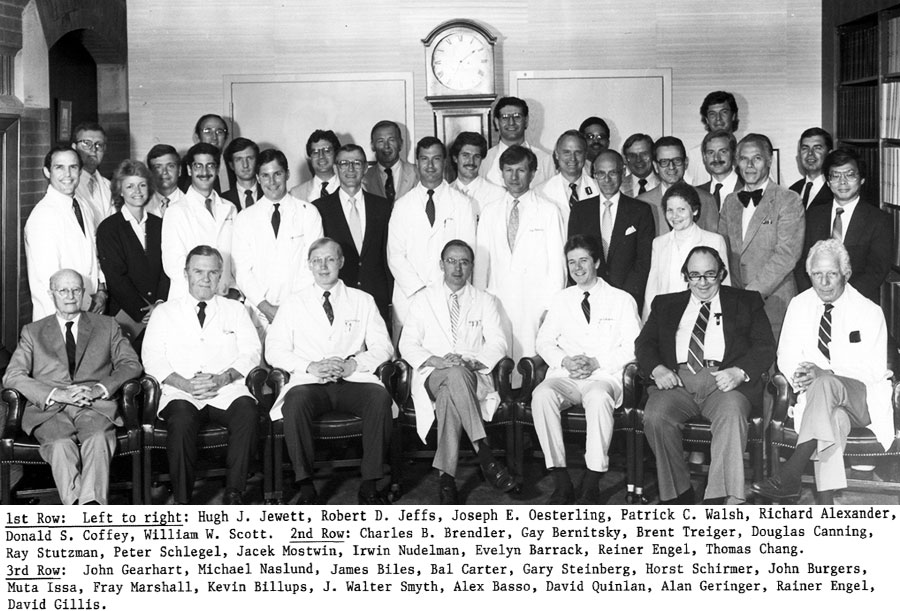
-
1988–1989 (Image):
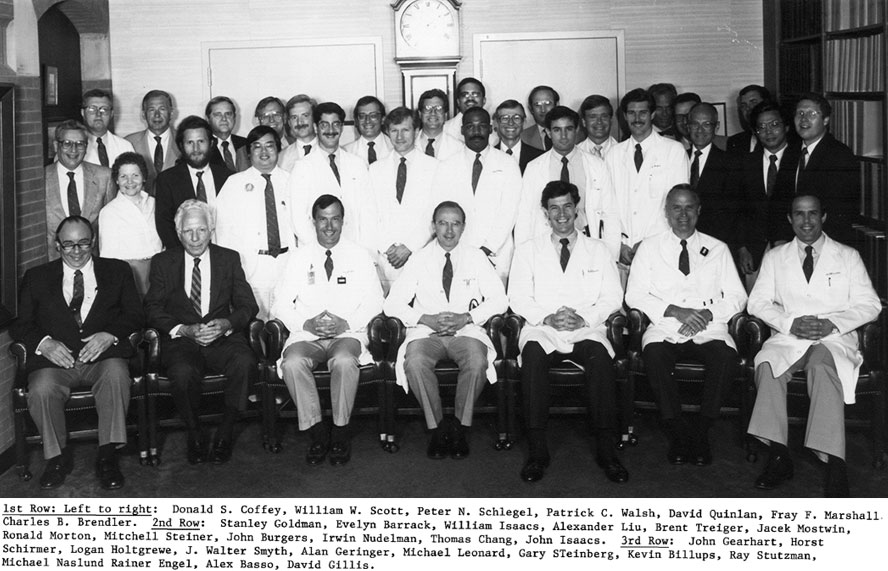
-
1990–1991 (Image):
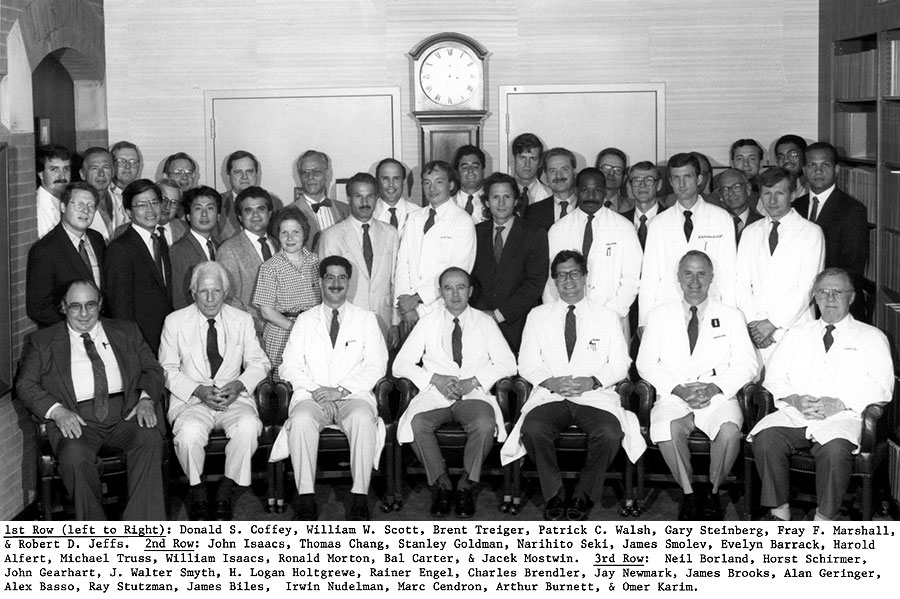
-
1991–1992 (Image):
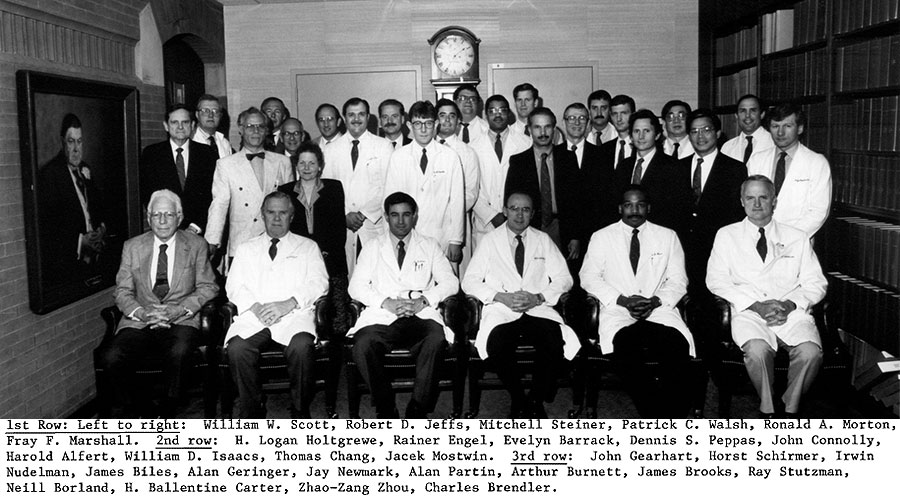
-
1992–1993 (Image):
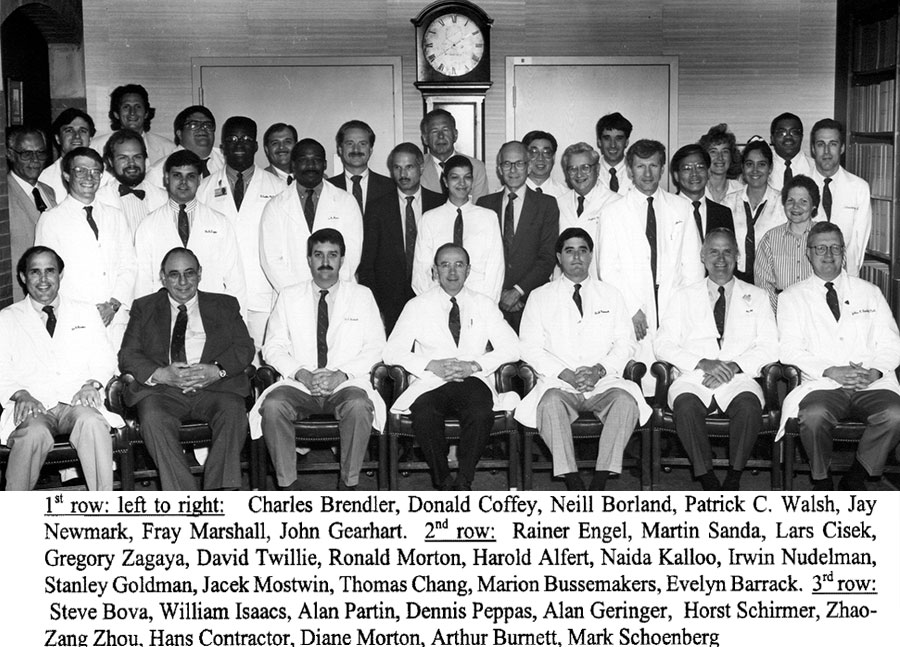
-
1994–1995 (Image):
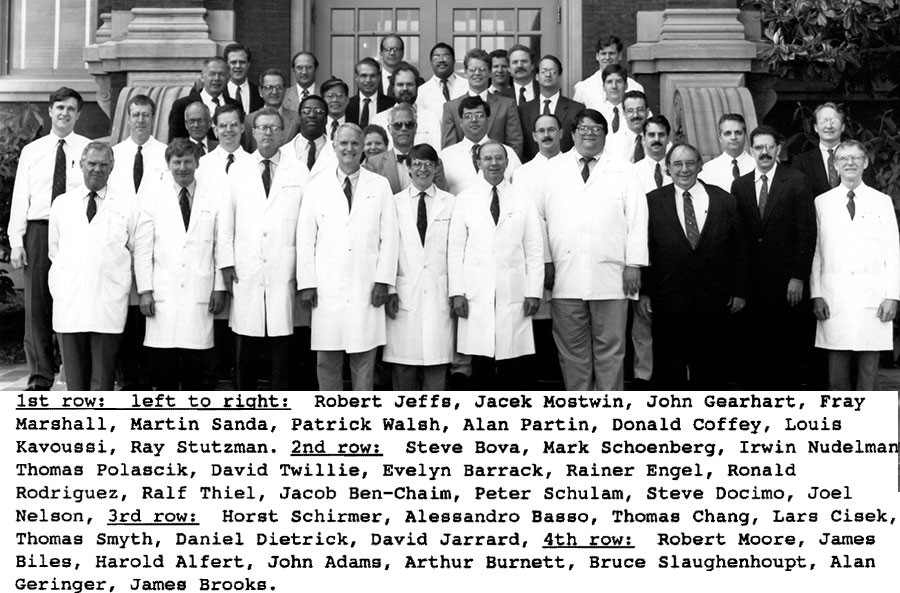
-
1996–1997 (Image):
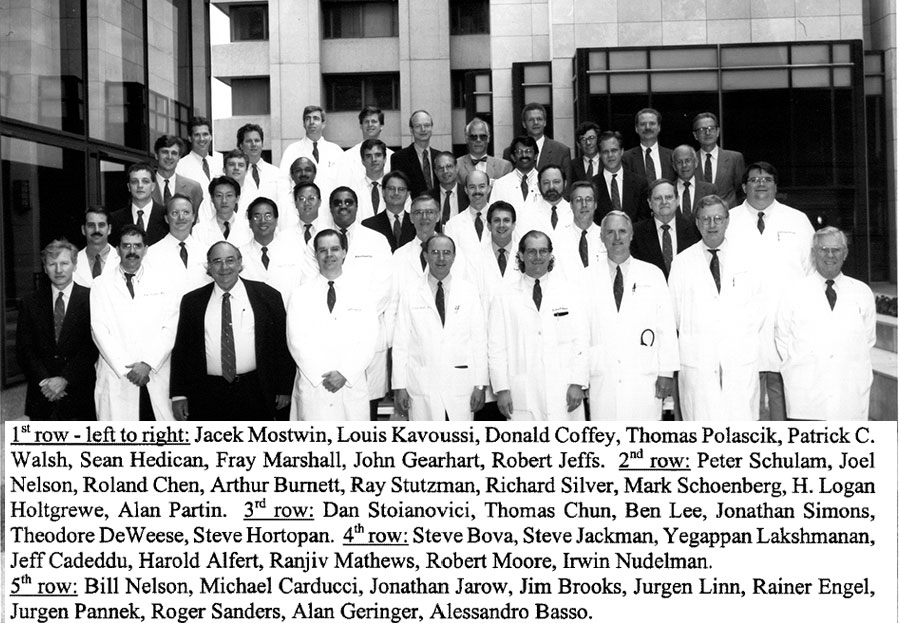
-
1997–1998 (Image):
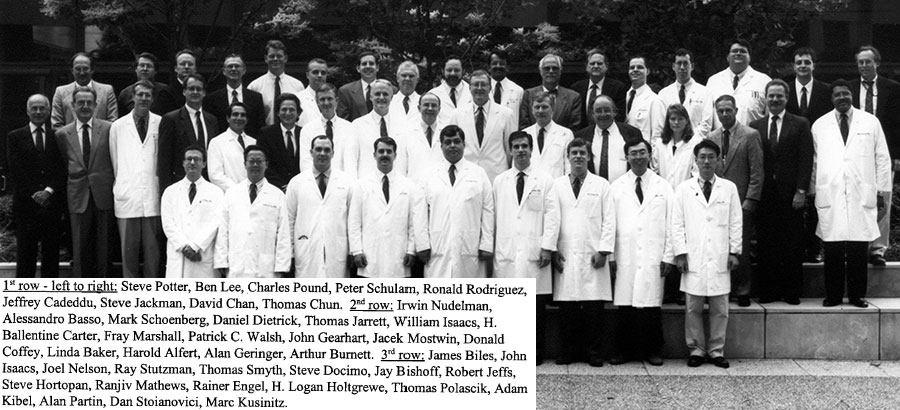
-
1998–1999 (Image):
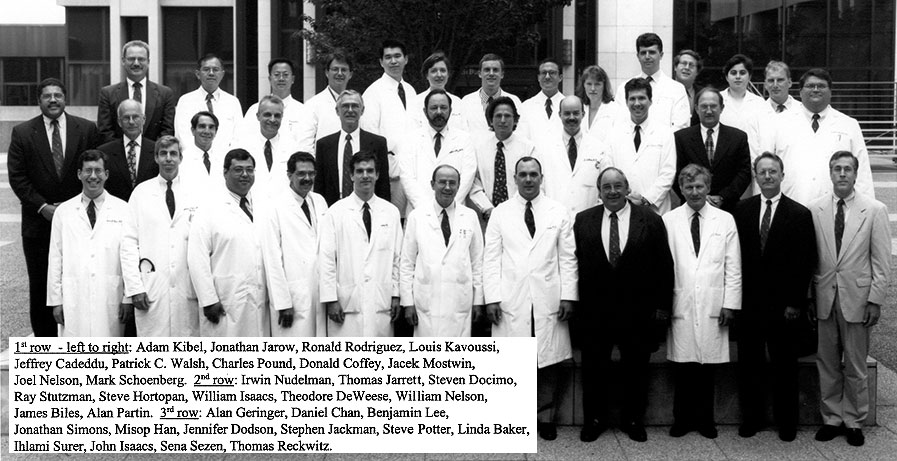
-
1999–2000 (Image):
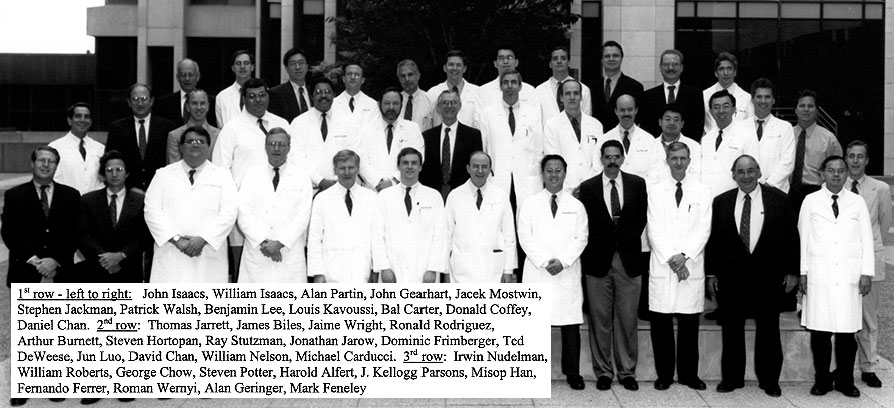
-
2001–2002 (Image):
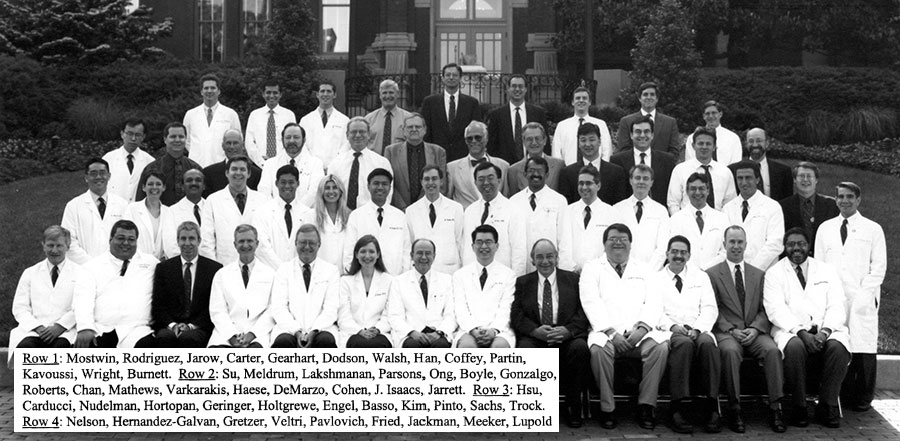
-
2002–2003 (Image):
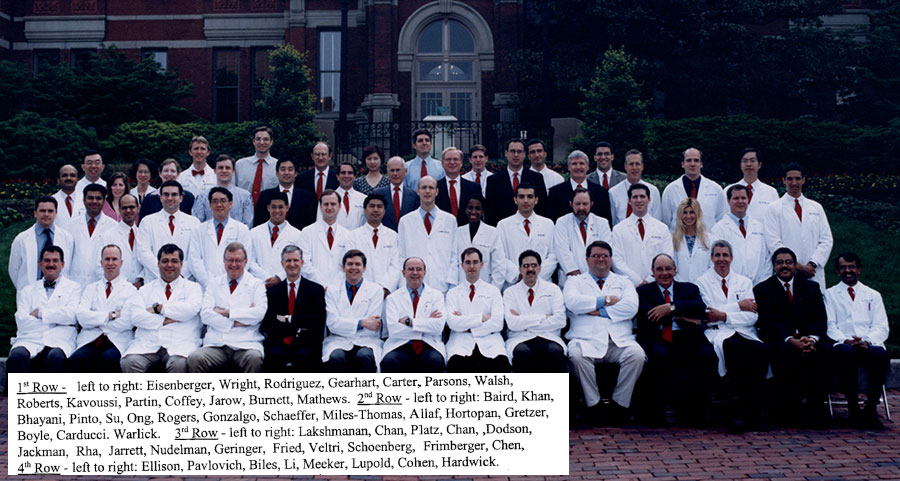
-
2004 (Image):

Brady Urological Institute 2004–Present
-
2005 (Image) :

-
2006 (Image) :

-
2007 (Image) :

-
2008 (Image) :

-
2009 (Image) :

-
2010 (Image) :

-
2011 (Image) :

-
2012 (Image) :

-
2013 (Image) :

-
2014 (Image) :

-
2015 (Image) :

The History of Urology at Johns Hopkins 1897 to 2013
Patrick Walsh, M.D., speaks to future leaders in the field of urology about the scientific and surgical contributions made by Johns Hopkins’ long line of renowned urologists.
Discoveries in Urology: Past, Present and Future
Donald S. Coffey, Ph.D., recounts the evolution of the Brady Urological Institute with historical highlights and personal anecdotes from his time as research director between 1974 and 2004.











